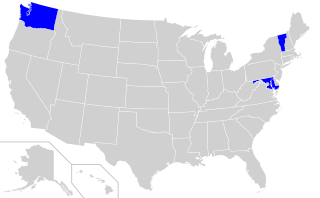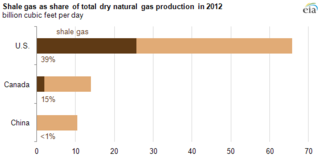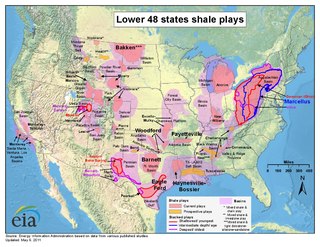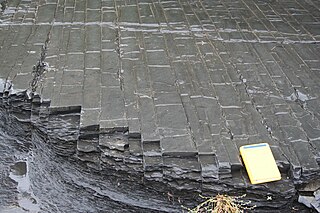Coterra Energy Inc. is a company engaged in hydrocarbon exploration organized in Delaware and based in Houston, Texas. The company has operations in the Permian Basin, Marcellus Shale, and the Anadarko Basin.
Chesapeake Energy Corporation is an American exploration and production company, headquartered in Oklahoma City.

The Barnett Shale is a geological formation located in the Bend Arch-Fort Worth Basin. It consists of sedimentary rocks dating from the Mississippian period in Texas. The formation underlies the city of Fort Worth and underlies 5,000 mi² (13,000 km²) and at least 17 counties.
Consol Energy Inc. is an American energy company with interests in coal headquartered in the suburb of Cecil Township, in the Southpointe complex, just outside Pittsburgh, Pennsylvania. In 2017, Consol formed two separate entities: CNX Resources Corporation and CONSOL Energy Inc. While CNX Resources Corp. focuses on natural gas, spin-off Consol Mining Corporation, now Consol Energy Inc. focuses on coal. In 2010, Consol was the leading producer of high-BTU bituminous coal in the United States and the U.S.'s largest underground coal mining company. The company employs more than 1,600 people.

Thomas Wingett Corbett Jr. is an American politician, lobbyist, and former prosecutor who served as the 46th governor of Pennsylvania from 2011 to 2015. A member of the Republican Party, he was also attorney general of Pennsylvania.

EQT Corporation is an American energy company engaged in hydrocarbon exploration and pipeline transport. It is headquartered in EQT Plaza in Pittsburgh, Pennsylvania.

Fracking in the United States began in 1949. According to the Department of Energy (DOE), by 2013 at least two million oil and gas wells in the US had been hydraulically fractured, and that of new wells being drilled, up to 95% are hydraulically fractured. The output from these wells makes up 43% of the oil production and 67% of the natural gas production in the United States. Environmental safety and health concerns about hydraulic fracturing emerged in the 1980s, and are still being debated at the state and federal levels.

XTO Energy Inc. is an American energy company and subsidiary of ExxonMobil principally operating in North America. Acquired by ExxonMobil in 2010 and based out of Spring, Texas, it is involved with the production, processing, transportation, and development of oil and natural gas resources. The company specializes in developing shale gas via unconventional means like hydraulic fracturing and horizontal drilling.

Shale gas is an unconventional natural gas that is found trapped within shale formations. Since the 1990s a combination of horizontal drilling and hydraulic fracturing has made large volumes of shale gas more economical to produce, and some analysts expect that shale gas will greatly expand worldwide energy supply.

Chief Oil & Gas is a company founded in Dallas, Texas in 1994 by Trevor Rees-Jones. Its primary holdings of natural gas were developed in the core areas of the Barnett Shale in Tarrant County, Denton County and Parker County. In 1999, new technology in horizontal drilling and hydraulic fracturing along with rising gas prices made the Barnett Shale, an unconventional resource for natural gas, more economical. Chief rapidly expanded its leasehold position and drilling and production program in the Barnett Shale to become the fields second largest producer there.

Shale gas in the United States is an available source of unconventional natural gas. Led by new applications of hydraulic fracturing technology and horizontal drilling, development of new sources of shale gas has offset declines in production from conventional gas reservoirs, and has led to major increases in reserves of U.S. natural gas. Largely due to shale gas discoveries, estimated reserves of natural gas in the United States in 2008 were 35% higher than in 2006.

The Utica Shale is a stratigraphical unit of Upper Ordovician age in the Appalachian Basin. It underlies much of the northeastern United States and adjacent parts of Canada.

The inclusion of unconventional shale gas with conventional gas reserves has caused a sharp increase in estimated recoverable natural gas in Canada. Until the 1990s success of hydraulic fracturing in the Barnett Shales of north Texas, shale gas was classed as "unconventional reserves" and was considered too expensive to recover. There are a number of prospective shale gas deposits in various stages of exploration and exploitation across the country, from British Columbia to Nova Scotia.

Fracking is a well stimulation technique involving the fracturing of formations in bedrock by a pressurized liquid. The process involves the high-pressure injection of "fracking fluid" into a wellbore to create cracks in the deep-rock formations through which natural gas, petroleum, and brine will flow more freely. When the hydraulic pressure is removed from the well, small grains of hydraulic fracturing proppants hold the fractures open.

Environmental impact of fracking in the United States has been an issue of public concern, and includes the contamination of ground and surface water, methane emissions, air pollution, migration of gases and fracking chemicals and radionuclides to the surface, the potential mishandling of solid waste, drill cuttings, increased seismicity and associated effects on human and ecosystem health. Research has determined that human health is affected. A number of instances with groundwater contamination have been documented due to well casing failures and illegal disposal practices, including confirmation of chemical, physical, and psychosocial hazards such as pregnancy and birth outcomes, migraine headaches, chronic rhinosinusitis, severe fatigue, asthma exacerbations, and psychological stress. While opponents of water safety regulation claim fracking has never caused any drinking water contamination, adherence to regulation and safety procedures is required to avoid further negative impacts.

The environmental impact of fracking is related to land use and water consumption, air emissions, including methane emissions, brine and fracturing fluid leakage, water contamination, noise pollution, and health. Water and air pollution are the biggest risks to human health from fracking. Research has determined that fracking negatively affects human health and drives climate change.
Stephanie Hallowich and Chris Hallowich, H/W, v. Range Resources Corporation, Williams Gas/Laurel Mountain Midstream, MarkWest Energy Partners, L.P., MarkWest Energy Group, L.L.C., and Pennsylvania Department of Environmental Protection was a case in the Court of Common Pleas of Washington County, Pennsylvania. The trial was held in August 2011.

The Marcellus natural gas trend is a large geographic area of prolific shale gas extraction from the Marcellus Shale or Marcellus Formation, of Devonian age, in the eastern United States. The shale play encompasses 104,000 square miles and stretches across Pennsylvania and West Virginia, and into eastern Ohio and western New York. In 2012, it was the largest source of natural gas in the United States, and production was still growing rapidly in 2013. The natural gas is trapped in low-permeability shale, and requires the well completion method of hydraulic fracturing to allow the gas to flow to the well bore. The surge in drilling activity in the Marcellus Shale since 2008 has generated both economic benefits and considerable controversy.

Countries using or considering to use fracking have implemented different regulations, including developing federal and regional legislation, and local zoning limitations. In 2011, after public pressure France became the first nation to ban hydraulic fracturing, based on the precautionary principle as well as the principal of preventive and corrective action of environmental hazards. The ban was upheld by an October 2013 ruling of the Constitutional Council. Some other countries have placed a temporary moratorium on the practice. Countries like the United Kingdom and South Africa, have lifted their bans, choosing to focus on regulation instead of outright prohibition. Germany has announced draft regulations that would allow using hydraulic fracturing for the exploitation of shale gas deposits with the exception of wetland areas.

CNX Resources Corporation is a natural gas company based in Pittsburgh with operations in the Appalachian Basin, primarily in the Marcellus Shale and Utica Shale in Pennsylvania, Ohio and West Virginia. It also develops coalbed methane properties in Virginia along with a methane capture and abatement program. The company also has extensive midstream operations and is one of the largest producers of natural gas in the United States.














